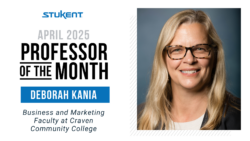Think back to your most memorable classroom experiences. Chances are, hands-on, scenario-based activities and projects had a lasting impact on your education.
Situating your students in authentic, real-world contexts makes learning more effective (and fun). However, building those experiences is tough — it takes time, energy, and resources busy educators may not have.
Stukent Simternships help you take the hassle out of creating experiential learning opportunities, but implementing a new instructional resource isn’t always as easy as ABC. To give you a few ideas, we’ve asked a few educators to share their favorite tips and tricks for implementing a Stukent Simternship in their courses!
Integrating a Simternship into Your Course Planning and Design
Every great learning experience starts with a set of meaningful objectives and goals. If you bundle a Stukent Simternship with its accompanying courseware, you’ll get a fully aligned, turnkey curriculum that supports any modality. Whether you’re teaching a face-to-face, hybrid, or online course, Stukent materials give you tools to help your students succeed.
But maybe you’d like more control over the content and sequencing of your course. Your colleagues’ advice? Start with the learning objectives. “Do your homework and make sure the simulation reflects your learning outcomes,” says Bret Skousen, professor of marketing at Utah Valley University. “Start small, maybe with one section, so you can really learn [the simulation] before expanding.”
Each Simternship features learning objectives at the beginning of each round. These learning objectives outline the content and indicate how students will demonstrate mastery of the material. To get started, analyze the Simternship’s learning objectives and identify where your course currently aligns with the simulation. Next, address any knowledge gaps between the simulation’s objectives and your current course sequence. Knowledge must come before practical application, so ensure students receive sufficient instruction on Simternship activities before they apply new principles to real-world scenarios.
“I try to pair the simulation with the concept being taught,” Skousen says. “So, for example, if we’re talking about pricing this week, we’ll do the pricing part of the simulation. It allows [students] to connect theory with application.” This just-in-time application reinforces students’ mental models of course concepts, which will facilitate knowledge transfer to their day-to-day lives as they approach subject mastery.
Similarly, the Stukent E3 Learning Experience illustrates how educators can sequence and align instructional activities to support robust learning outcomes and student employability. In the figure below, the horizontal axis represents the knowledge acquisition track you’ll find in Stukent courseware. The vertical axis and circular diagram represent the skill-building track, which can be accomplished with a Simternship or experiential learning project.
While a deep dive into the E3 Learning Experience is beyond the scope of this post, the model does show the holistic, integrated learning experience that Stukent Simternships and courseware provide for you and your students. Better yet, it gives you a roadmap for building the kinds of learning experiences that foster long-term student success!
| Get more information on the E3 Learning Experience! Ann-Michelle Levangie, director of instructional design at Stukent, presented the learning experience and instructional model at ProfCon 2024. Listen to her remarks and follow along with her slide deck. |
While students cycle through parts of the E3 Learning Experience with each module, some professors take a different approach to knowledge and skill acquisition. “We do the first half of the semester in the textbook with lectures, case studies, and presentations — all that traditional stuff,” says Tammy Katuin, a professor from Valley City State University. She continues, “[We] transition into applying this knowledge and turning it into skills using the simulation” in the second half of the semester.
Simternships are designed to be formative learning experiences — they give students the ability to build proficiency in low-risk environments. However, some professors also implement simulations as a final project or summative assessment. “I’ve also had success using simulations at the very end of the semester as a capstone project,” says Skousen. “Students go through all the course concepts first, then apply everything in a simulated environment.”
To sum it up, a Simternship gives you a flexible way to implement experiential, work-integrated learning in your course. Whether you assign rounds throughout your course or use it as a capstone project, your students will thank you for the experience!
Making Connections with Simternships
A Simternship doesn’t have to be a solitary journey — it can be an opportunity for meaningful connections, too. Students thrive when they interact with you, collaborate with one another, and connect the course material to their wider world.
While a Simternship may be an individualized learning experience, students benefit from learner-to-instructor and learner-to-learner interactions. Rebecca Cooney of Washington State University says, “I created a Simulation Support Group discussion forum in Canvas. It gives students a place to ask questions, share resources, and help each other out. It’s the most popular discussion board in my class.” The practice of building meaningful connections between students and instructors is known as social presence in education theory, and it can be an effective technique to engage students on a deep level. Social presence can be fostered through consistent, authentic learner-to-instructor and learner-to-learner interactions in a course.
Traci Bitler of Rhodes State College agrees: “In my online courses, I offer discussion boards where students can post challenges and strategies. The students help each other out, and it builds a sense of community, even in a digital space.”
For face-to-face courses, Ryan Russell of the University of Tennessee at Chattanooga takes a different approach: “I designate ‘Sim Days’ on the course schedule. These sessions are designed to walk through each round of the simulation together, review supplemental materials in real time, and guide students through decision-making.”
In short, providing students with a social space to collaborate on their Simternships can not only deepen engagement, but also foster belonging, motivation, and critical thinking. When students feel connected, they’re more likely to take ownership of their learning experience.
Next, there’s nothing wrong with a little friendly competition! Bitler says, “I create a competitive atmosphere by offering bonus points to the top three students in the rankings. It keeps students engaged and creates friendly competition in the classroom and online discussion boards.” Competition can be a great motivator, pushing students to stay engaged and put their best efforts into the Simternship. Plus, the excitement of a challenge can make learning more dynamic and rewarding for some students.
Finally, reflection is an essential instructional tool, and yet it’s often overlooked in the classroom. Bret Skousen makes it a priority, saying, “I have students do a ton of reflection during each round of the simulation. I think that’s where most of the learning actually takes place — they hate it in the beginning, but by the end, they realize that’s where they learned the most.” Prompt your students to pause and reflect on a regular basis — this practice helps students connect course concepts to their lived experiences, which promotes knowledge transfer to their daily lives.
Future iterations of Stukent courseware will include Broaden Your Perspective prompts, which will encourage students to reflect on their coursework at regular intervals.
A Note on Academic Dishonesty
With the rise of ChatGPT and other large language models (LLMs), educators have become increasingly concerned about academic dishonesty. Over the last two years, anecdotal tales of students using AI to conduct research, write papers, and even email their professors have flooded educator forums and discussion boards.
However, “rather than claiming to be able to eliminate cheating entirely, Stukent focuses on designing a learning experience grounded in research,” writes Ann-Michelle Levangie, director of instructional design at Stukent. “Research supports the idea that experiential learning reduces cheating risk by embedding knowledge and skill application into authentic tasks,” she continues (Levangie, 2025, pp. 1-2).
That’s exactly what makes Simternships such a powerful tool. Unlike traditional assignments, Simternships present real-world challenges that require critical thinking, strategic decision-making, and adaptability. There’s not always a “right answer” to copy because decisions often lead to unique outcomes based on complex variables.
Stukent team members often joke that Simternships are “the homework your students want to do,” and it’s true — a Simternship offers students a work-integrated, career-relevant experience that has a direct impact on their future earning potential. When students succeed in a Simternship today, they’re prepared to step confidently into their career tomorrow.
Implementing a Simternship in your course isn’t just about adding another assignment — it’s about transforming the way students engage with learning. Whether you use a Simternship to reinforce concepts, build social presence, or prevent academic dishonesty, one thing is clear: Your students will gain more than just knowledge — they’ll gain real-world experience.
To learn about Stukent Simternships and courseware and to get FREE instructor access to Stukent materials, visit our website.
References: Levangie, A. (2025). Stukent’s approach to academic integrity. [Internal document]. Stukent.
Levangie, A. (2025). The Stukent E3 Learning Experience. [Unpublished manuscript]. Stukent.






